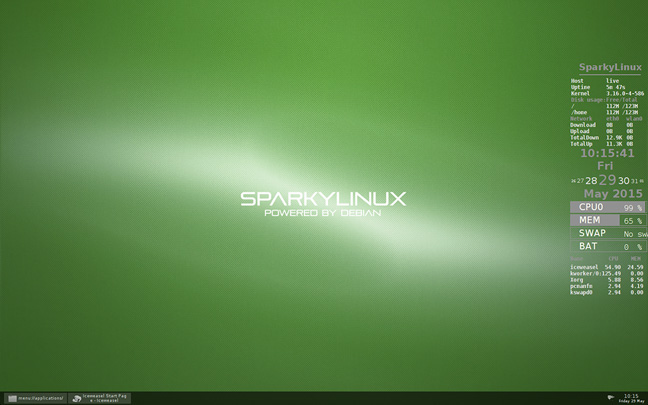This article is more than 1 year old
Five lightweight Linux desktop worlds for extreme open-sourcers
Need a slim-line work environment? We recommend the best
SparkyLinux (with Openbox)
Before Crunchbang++ reached a stable release, I experimented with SparkyLinux. This relatively small distro is available in a wide variety of desktop flavors, but I've only tested the lightweight Openbox option.
Like Crunchbang++, Sparky is built on a Debian base, so package-wise things are very close. SparkyLinux uses a mix of its own repos and Debian Testing, so if you're looking for a more stable way to run a minimal setup on Debian Testing, this might be a better bet than telling Crunchbang to use Testing packages (which has been unpredictable in my experience).
Sparky has a very different look and feel to Crunchbang++, not quite as refined, but in some ways it's simpler and less resource intensive than Crunchbang++. For example, the default file manager is PCManFM, which is little bit lighter than Thunar. SparkyLinux opts for a bottom menu bar and a more verbose default Conky setup as well.
I should note that while I had no trouble installing SparkyLinux on actual hardware, it would not play nice in virtual machines, so if you want to try it you may want to make some room on your hard drive and install it alongside whatever you're using now.
DIY Debian/Arch
Since both Sparky and Crunchbang++ are based on Debian it's worth asking why not just install the Debian base system and add the handful of packages you need yourself? If you want to create a custom, highly personalized, lightweight Linux desktop that's literally everything you want and nothing you don't, this is the way to go.
The only downside is that building your ultimate setup is time consuming. In my experience "a handful" of packages actually turns out to be thousands and you'll get to find out about each package manager's shortcomings when it comes to installing and managing dependencies.
Arch is, of course a very DIY distro. That's a big part of the "Arch way," and provided you can get through the arduous installation process, Arch makes a fantastic base for a minimal Linux desktop.
I tested Arch with Openbox, Tint2 and Thunar, essentially rolling my own Arch-based Crunchbang and was relatively happy with the results. That said, it took me the better part of a week to get everything set up and all the hardware quirks worked out – the same is true of my Debian minimal setup – and in the end, I got Crunchbang.
If you don't mind putting in the time, going the DIY route with either Arch or Debian will get you the most highly customized, everything-you-want, nothing-you-don't setup. Just be prepared to invest some time.

